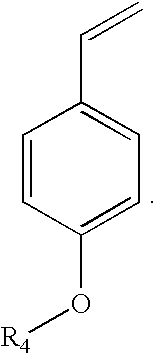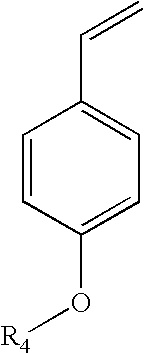Method for preparing para-hydroxystyrene by biocatalytic decarboxylation of para-hydroxycinnamic acid in a biphasic reaction medium
a para-hydroxycinnamic acid and reaction medium technology, applied in the field of molecular biology and microbiology, can solve the problems of large amount of unwanted byproducts, high reaction temperature, and strong acidic or basic reaction conditions
- Summary
- Abstract
- Description
- Claims
- Application Information
AI Technical Summary
Benefits of technology
Problems solved by technology
Method used
Image
Examples
example 1
Production of Cell-Free Extracts of PDC1 and PDC2 Enzymes from E. coli Overexpressing Strains
[0136]The purpose of this Example was to produce cell-free extracts of the para-hydroxycinnamic acid decarboxylase enzymes PDC1 (Lactobacillus plantarum) and PDC2 (Bacillus subtilis) from E. coli overexpressing strains. Two plasmids, pET17.pdc1 and pET17.pdc2, were constructed that overexpress the PDC1 and PDC2 enzymes, respectively. These plasmids were used to transform E. coli strain BL21 to produce the two overexpressing strains that had high percentages of decarboxylase protein and activity. The cell-free extracts were obtained by lysing the cells using a French press.
Construction of PDC1 and PDC2 E. coli Overexpressing Strains:
[0137]The pdc genes, pdc1 (SEQ ID NO:1) and pdc2 (SEQ ID NO:3), were amplified by PCR using genomic DNA from L. plantarum and B. subtilis, respectively, as templates. The genomic DNA was isolated from L. plantarum grown on MRS medium and B. subtilis grown on LB me...
example 2
Decarboxylase Activity of PDC2 Cell-Free Extract in a Biphasic Reaction Medium
[0145]The purpose of this Example was to demonstrate the advantage of using the PDC2 cell-free extract to produce pHS in a biphasic reaction medium. The retention of PDC2 enzymatic activity was measured in aqueous / toluene, aqueous / dichloromethane, and aqueous / methyl decanoate biphasic reaction media.
[0146]A glass scintillation vial containing a small stir bar was charged with 5 mL of one of the following water-immiscible organic solvents, spectral grades of toluene, dichloromethane, or methyl decanoate. Then, 10 mL of a PHCA substrate solution (30 to 120 mM PHCA solution in 0.2 M sodium phosphate, pH 6.0 with 1.2 mg / mL BSA) and 15 μL of PDC2 cell-free extract (150 μg protein; 15 Units), prepared as described in Example 1, were added. The vial was capped, placed on a magnetic stir plate and vigorously stirred. The reaction was allowed to proceed for a time period sufficient for conversion of the pHCA to pHS...
example 3
Comparative Example of the Decarboxylase Activity of PDC2 Cell-Free Extract in a Single-Phase Aqueous Reaction Medium
[0149]The purpose of this Example was to measure the retention of enzymatic activity of PDC2 cell-free extract in a single-phase aqueous reaction medium to serve as a comparison for the biphasic reaction medium described in Example 2.
[0150]A glass scintillation vial containing a small stir bar was charged with 10 mL of pHCA solution (30 mM pHCA solution in 0.2 M sodium phosphate, pH 6.0 with 1.2 mg / mL BSA). Then, 15 μL of PDC2 cell-free extract (150 μg protein, 15 Units), prepared as described in Example 1, was added to initiate the reaction. The vial was capped, placed on a magnetic stir plate and was vigorously stirred. The reaction was allowed to proceed for a time period sufficient for the complete conversion of the pHCA to pHS. During the course of the reaction, the reaction progress was monitored by TLC, UVNIS and HPLC, as described in the General Methods sectio...
PUM
| Property | Measurement | Unit |
|---|---|---|
| temperature | aaaaa | aaaaa |
| temperature | aaaaa | aaaaa |
| pH | aaaaa | aaaaa |
Abstract
Description
Claims
Application Information
 Login to View More
Login to View More - R&D
- Intellectual Property
- Life Sciences
- Materials
- Tech Scout
- Unparalleled Data Quality
- Higher Quality Content
- 60% Fewer Hallucinations
Browse by: Latest US Patents, China's latest patents, Technical Efficacy Thesaurus, Application Domain, Technology Topic, Popular Technical Reports.
© 2025 PatSnap. All rights reserved.Legal|Privacy policy|Modern Slavery Act Transparency Statement|Sitemap|About US| Contact US: help@patsnap.com



